Amid all the over-commercialised hype surrounding Halloween it is easy to forget that the origins of this festival lie in the ancient Celtic celebration of Samhain. Midway between the autumn equinox and the winter solstice it marked the end of the harvest and a time to prepare for the colder months of the year.
Our own circadian rhythms should slow down too after the frenetic pace of long summer days. Nature is also getting its house in order to survive the darker months ahead.
Leaves have already faded and the trees have finished their job of food production with timber growth ceased after a spring and summer of remarkable productivity. The late Michael Viney wrote, “even bracken redeems itself in dying: nothing else has quite that vivid shade of burnt sienna, richest of all when sodden and curling into rust”.
Bats, hedgehogs, newts and lizards seek out dark places to slow their body processes in order to survive the cold. The last of the swallows have gone and squirrels and jays have secreted away their essential stores of nuts and seeds in caches in the soil which they will seek out as their hunger grows in winter. Insects are mainly in a stage of overwintering stupor or buried in the soil as pupae to emerge in the spring.
READ MORE
In folklore, it was believed that fairies also lived underground in a parallel world to our own human habitats. Country people feared disturbing or angering them at this time of year.
Particular features of the landscape, such as stone circles, rings of fungi in the grass or special trees like old hawthorns were avoided and certainly not damaged for fear of upsetting these magical beings. Even to this day, a lone hawthorn in a field is often left alone to grow old and wizened, unlike its companions in the hedges that are too frequently trimmed.
In early Christian tradition, some hawthorns were believed to have powers of healing or were decorated with rags and used as prayer trees. This reluctance to interfere with natural features could well be applied to the rest of the natural world.
Hawthorn (known as whitethorn in many country areas) is one of nature’s great providers. One of the most productive shrubs of hedges and woodlands, it offers shelter in its thorny branches, forage in its flowers and leaves and a store of winter food in its abundant berries or haws.
It forms the main structure in a majority of the hedgerows across this country, thus creating essential corridors for animals, such as bats and wrens that prefer not to cross open ground.
Now is the time when we value secure places to store provisions
— Richard Nairn
One strategy that mobile species, such as waterbirds, use to survive the colder months is migration. As darkness closes in on the northern part of the globe, they gather in flocks and head south to spend the winter in less harsh conditions. Ireland is one of the migration crossroads of Europe, lying midway between the arctic and the tropics.
Our relatively mild, damp winters are attractive for a wide range of waders, ducks, geese and other waterbirds that crowd into the estuaries and freshwater habitats at this time of year. When ice and snow grip more continental areas to the east, big flocks of starlings, thrushes and finches move west to our island to find unfrozen ground and stores of natural food.
This year has been one of abundance in nature and in the garden. The warm spring and long sunny days of summer now seem long ago but they have left their mark with fast growth rates in trees, plentiful hedgerow fruits and lots of young birds.
Last weekend, the annual Winterage Festival took place in the Burren, when the farmers followed their long-established tradition of moving their cattle from lowland pastures to the upland areas where they benefit from the abundant forage and “underfloor heating” from the limestone rock.
It was also an occasion to welcome the latest group of Farming for Nature ambassadors to the growing network of landowners who are making space for nature.
This is a time of celebration and preparation. Now is the time when we value secure places to store provisions for the winter including hay from the meadow, fruits from the orchard and logs for the winter fire.
So, we should celebrate Samhain as well as Halloween, not only as a time to give thanks for the abundant harvest but as a way of reconnecting with nature as we too prepare for another winter.
Richard Nairn is an ecologist and writer. His most recent book is entitled Future Wild.

















